Steemit Crypto Academy / S4:W7 / Homework post for @yohan2on || The Governance of Tron Ecosystem by @moohsin
Greetings, Steemians!
I'm fine, and I hope everyone else is as well. This homework post by prof @yohan2on which contains the information about Tron ecosystem. Let's get started on this topic with my homework post.
.jpg)

Question no 1:
Who are Super Representatives, SR partners and SR candidates? (The Governance of the TRON Ecosystem)
Tron Ecosystem:
The Tron ecosystem is a decentralized blockchain that allows creators to market and sell their work directly to clients, bypassing the need for an intermediary. DApps, Smart Contracts, and DApp tokens can all be built on the Tron blockchain by developers. Tronix, the Tron blockchain's native coin, is used within the network and serves as its governance token. The Tron Ecosystem uses the Delegated Proof of Stake (DPoS) consensus process, in which chosen delegates are in charge of transaction validation and block generation. The users choose these witnesses through a voting mechanism. Users who have put their Tron into the ecosystem are the only ones who can vote. Super Representatives are the delegates that have been chosen, and they are ranked from 1 to 27. The Super Representative Partners are ranked from 28th-127th, followed by the Super Representative Candidates. According on the number of votes they receive from TRON network users, each of them symbolizes a different hierarchical rank. They will each have a distinct role and function.
Super Representatives (SR):
The major block producers in the Tron Network are Super Representatives, who are block producers numbered from 1 to 27 on the list of block producers. Tron Power can be used to vote for block makers on the Tron Network (TP). Because the TP is determined by the number of TRX staked, unstaked TRX does not count in the vote. Every 6 hours, the votes are counted, and new votes take precedence over previous ones.
Every 3 seconds, the Super Representative generates a block, and for each block mined, the Super Representative receives 16 TRX. The network's committee is made up of Super Representatives, who have the authority to propose changes to the network, such as transaction costs, block production reward amounts, account creation fees, SR generation rewards, and so on.
Anyone who stakes some TRX tokens is eligible to vote in the Super Representatives' voting every 6 hours. Token holders are needed to vote with Tron Power. Tron Power and TRX currencies have a 1:1 ratio. This simply means that the account is eligible to cast one vote for every 1 TRX staked. The 27 Super Representatives begin producing blocks and validating transactions after each vote round. The Super Representative receives 32 TRX for each block produced and added to the chain. Those who do not have enough votes to be included in the 27 Super Representatives are relegated to the next level of governance who are known as super representative partners.
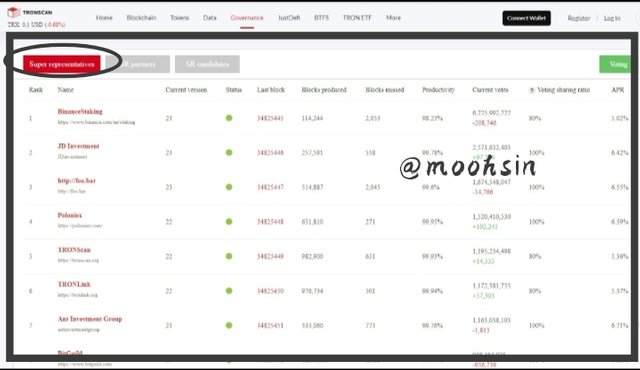
Super Representative Partners:
The Super Representative Partners are the next level of the governance hierarchy. These are the accounts that received the most votes after the Super representatives took the top 27 slots. In order of the number of votes received, they are numbered from 28 to 127. The SR partners are not responsible for producing blocks or validating transactions. They do, however, get some gains from the blocks they build. The awards they receive are proportional to the number of votes they receive during each round of voting. The SR partners participate in ecosystem governance by proposing ideas that, if chosen and implemented, have an impact on the ecosystem's overall functioning.
They've also been observed voting in the ecosystem's voting events, which are intended at enhancing Blockchain governance. They can also provide suggestions that are in line with the objectives of the Super Representative. Ordinary voters are also compensated in accordance to SRP incentives when they stake for voting.
.jpeg)
Super Representative Candidate:
Super representative candidates are the 147 nodes picked by the whole Tron blockchain's token holders. There are a total of 127 Super Representatives and Super Representative Partners. They are in charge of the Tron platform's governance as a collective organisation. After the voting was completed, some accounts did not make it to the top 127 from 147. Hence are referred to as super representative candidates. Because each voting round takes 6 hours, candidates would have to wait and expect that they would be chosen in the following round. They'd like to get into the top 127. They are not compensated for any blocks they produce because they are not part of the top group.
Each account that has a balance of TRX tokens is eligible to run as a node in the next election. The election, which takes place in 6 hour rounds, selects which accounts will be selected as Super Representatives (top 27 most voted) or Super Representative Partners based on the number of votes received (top 28th to 127th most voted).
.jpeg)

Question no 2:
What’s the difference between DPOS and POS consensus mechanisms?
Proof of Stake (PoS):
The Proof of Stake (PoS) algorithm is a sort of consensus in which individuals or nodes are chosen based on the amount of token staked to create blocks and legal blockchain transactions. The staked tokens would be viewed as collateral, allowing them to be placed in such a crucial position. POS is a substantial improvement over the Proof of Work (POW) method, which is inherently slow and consumes a lot of energy.
This consensus algotithm that does not necessitate the expenditure of a lot of energy to validate and produce blocks; instead, users stake their tokens, and the algorithm chooses a random staked account to validate the transactions mechanically.
Delegated Proof of Stake (DPoS):
The Delegated Proof of Stake algorithm is a step forward from the POS algorithm. It establishes a democratic procedure for selecting validators. DPOS is a hybrid voting and reputation system in which every elected node contributes significantly to the overall decision-making process. Since the delegates are elected in a democratic manner to determine the validator of transactions on the blockchain, no single individual may wield the most authority or influence decision-making in DPOS.
Delegate voting is done by nodes staking their assets in a stake pool linked to the delegated node, which gives the delegated node a higher stake in the blockchain's token. Transaction fees, which are allocated based on the percentage of tokens invested in the subaccounts by the voter, are used to compensate the chosen delegates.
Differencesbetween DPOS and POS consensus mechanisms:
| DPOS | POS | The DPoS (Delegated Proof of Stake) resolution mechanism is a more advanced version of the POS consensus procedures. Participants are commonly referred to as block creators or spectators in blockchain systems. | It deals with the subject of fragility. It is, in fact, a consensus system that was created in response to the need for development leads. The more interests there are in an active ecosystem, the more operations are examined and authenticated. |
|---|---|
| Collateral Staking, Delegation, and Voting techniques are used to provide Delegated Proof of Stake (DPoS) security. Delegated Proof-of-Stake (DPoS) is considered to be more secure than Proof-of-Stake due to the randomised probability of selecting a new delegate node (PoS). Assaults on the Blockchain are no longer permitted. | Proof of Stake (PoS) security is provided through Collateral Staking. |
| There appears to be a voting system in place where the bigger a voter's vote total, the less weight such account valuation should be given. | The examiners that are utilised to validate each block are really chosen in no particular order. You can choose all of the blocks that need to be authenticated at any point in time. |
| Delegated proof of stake (DPos) has a faster validation speed than other methods. | Proof of stake (PoS) validation takes a long time, it has quite slow validation speed |
| Delegated proof of stake (DPoS) will not scale well because voting is required to select nodes. | Proof-of-stake (PoS) is a decentralised network that allows for the creation and spread of nodes based on the quantity of assets staked. |
| Users vote to elect delegates in Delegated Proof of Stake (DPoS). | In Proof of Stake (PoS), delegates are chosen at random based on their stakes. |
| It has greater resilience because its blocks are made more instinctively. This method does not seem to elevate any one set of people; rather, it empowers stakeholders to gain a more democratic reputation. | Validators appear to be at greater risk of losing their staked tokens, hence systems based on POS Consensus Algorithms appear to be quite safe. Due to the fact that its blocks take longer to process, it has less flexibility. |
| Pooling strategies are used to elect new participants in a public election. You can improve security by choosing consensus mechanisms in an unusual way, such as by voting. | PoS does not use a pooling mechanism to select validators in a logical manner. It has a low security rating for enforcement. |

Question no 3:
Write a Step by Step tutorial showcasing how to stake/freeze TRX and vote for SRs
I will be using Tronlink pro app to demonstrate how to stake/freeze trx and vote super representatives (SR's). Below is the step by step method provided by the help of which one can easily understand this method of freezing and voting.
- Launch the tronlink pro wallet app on your mobile.
- Open the app on your device and then press the freeze button on the home screen (located on the right side of the screen).
- A new screen will appear on the app namely resources where you can see that I have no voting rights because I have never frozen my trx for voting before.
- Enter the desired amount of trx to be frozen. In this regard, I've entered 10 trx.
- To confirm your trx amount, press the confirm button and enter the password.
- Your 10 voting rights wll be provided to you. You can see my 10 voting rights in screenshots provided below.
- To vote, go back to the main screen, you'll notice a vote option, so click it.
- When you press the vote button, your screen will display a list of SRs.
- Now select the super representative for whom you wish to cast your vote. I went for binance staking.
- I cast my ten votes for binancestaking, which has a 5.01% expected yield.
- Now enter the password of your tronlink pro app again.
- My voting is complete, as evidenced by the fact that the number of open votes in the screenshot is 0, down from 10 previously.
All the screenshots of the above steps are also provided below;
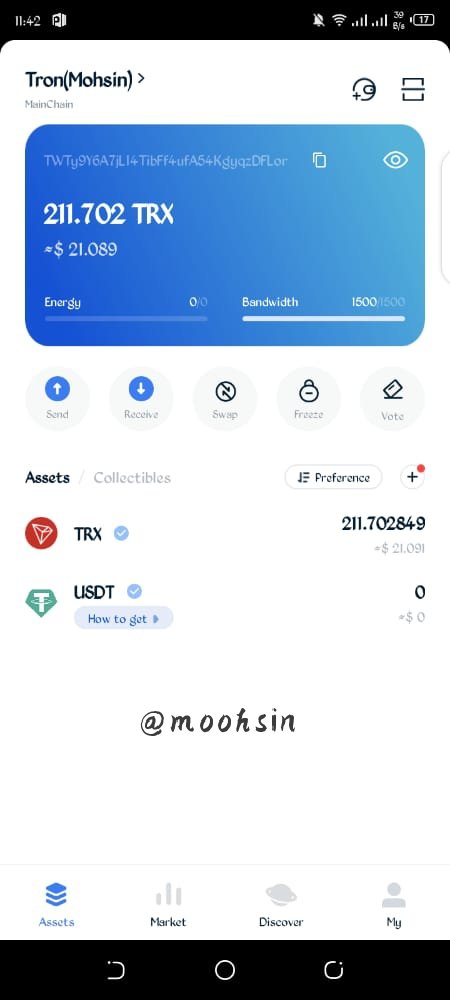
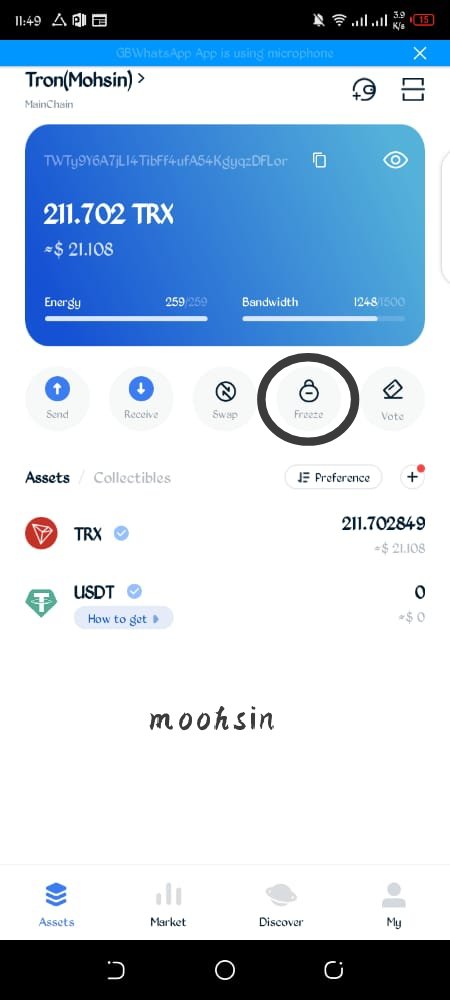
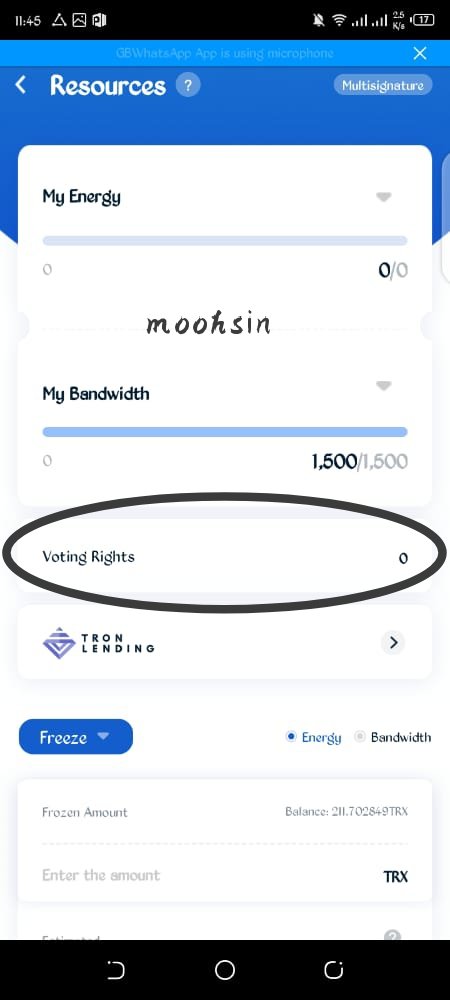
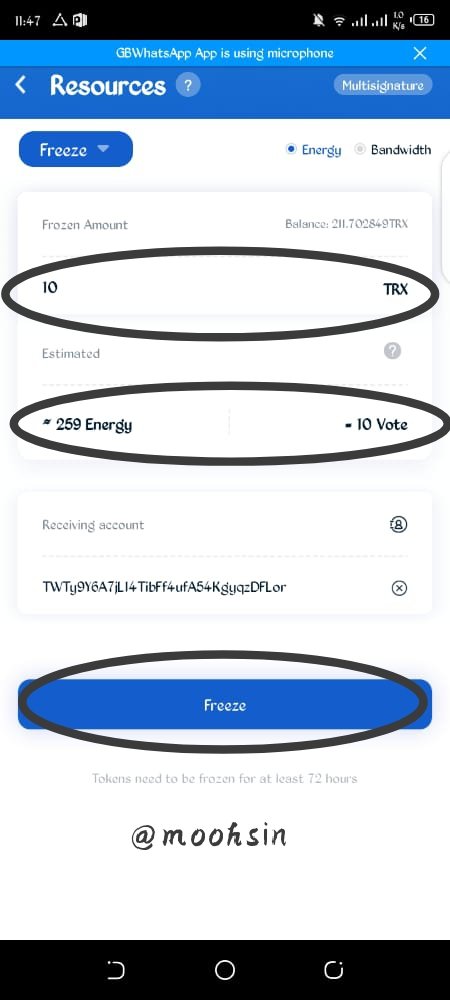
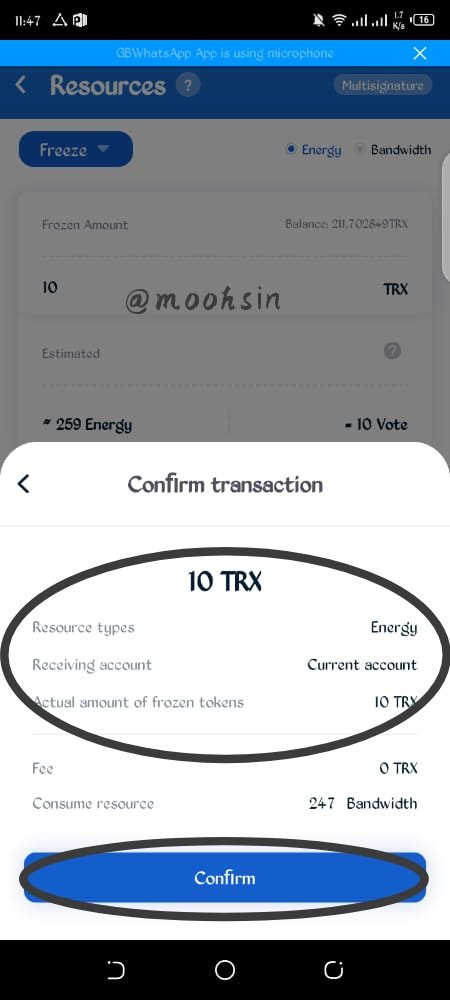
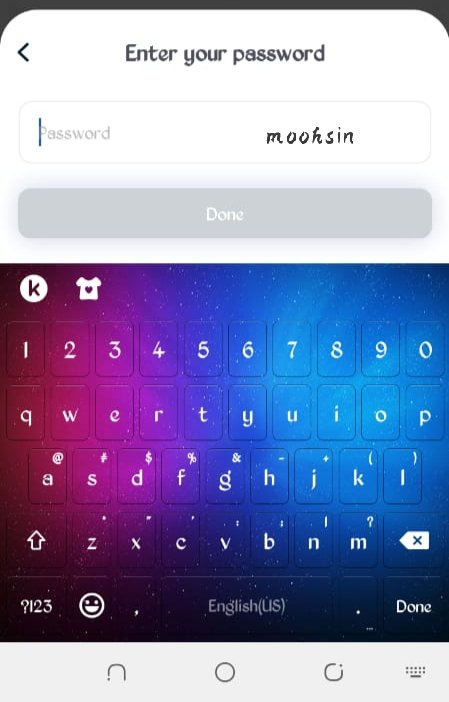
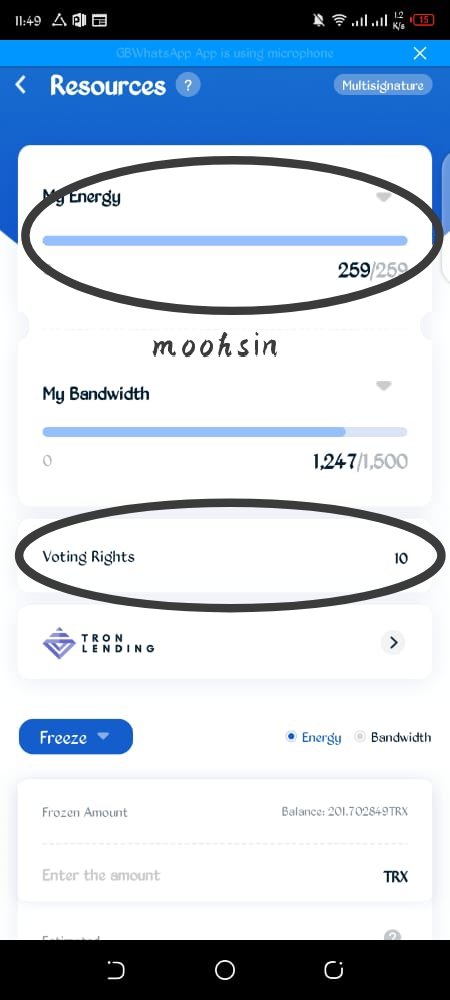
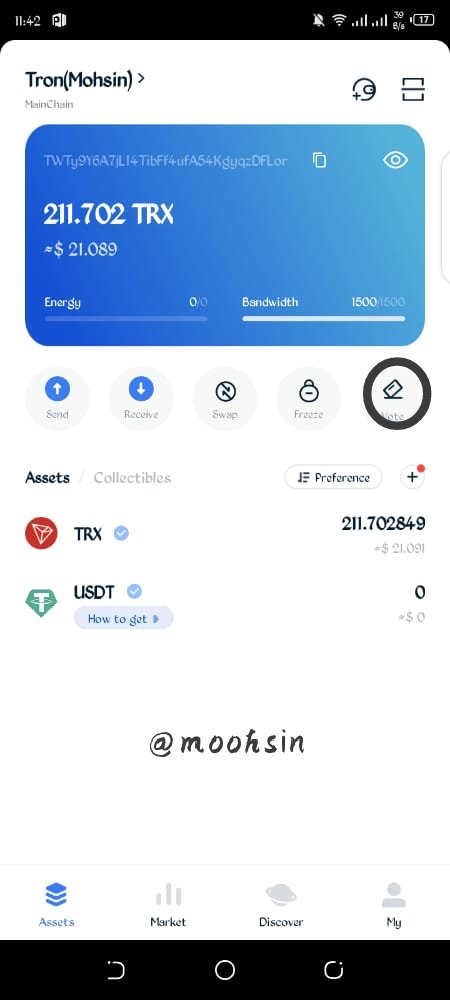
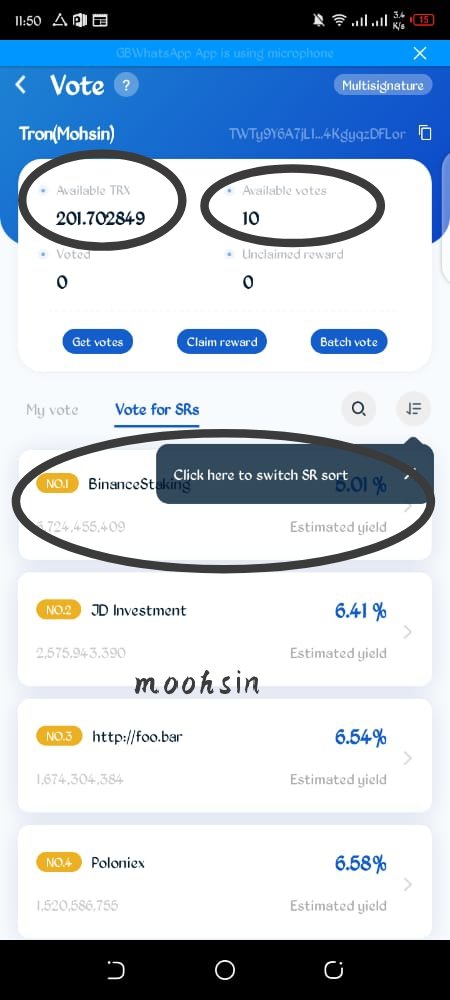
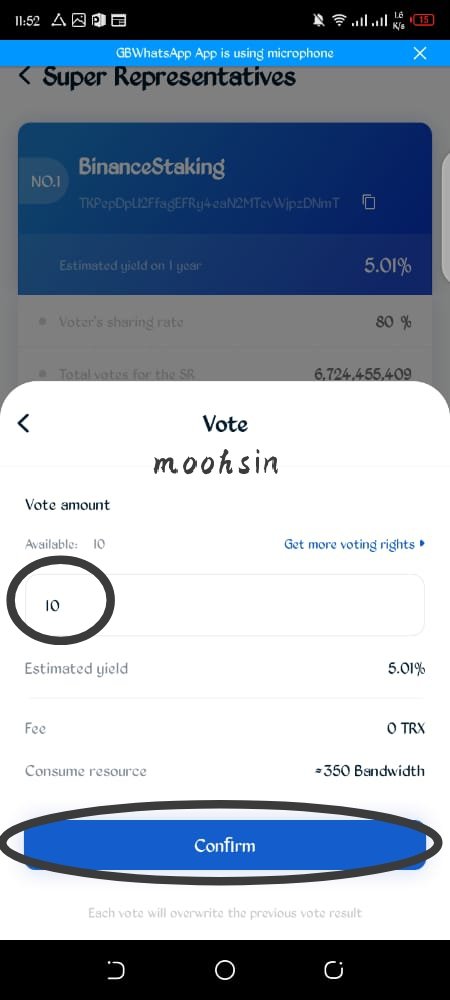
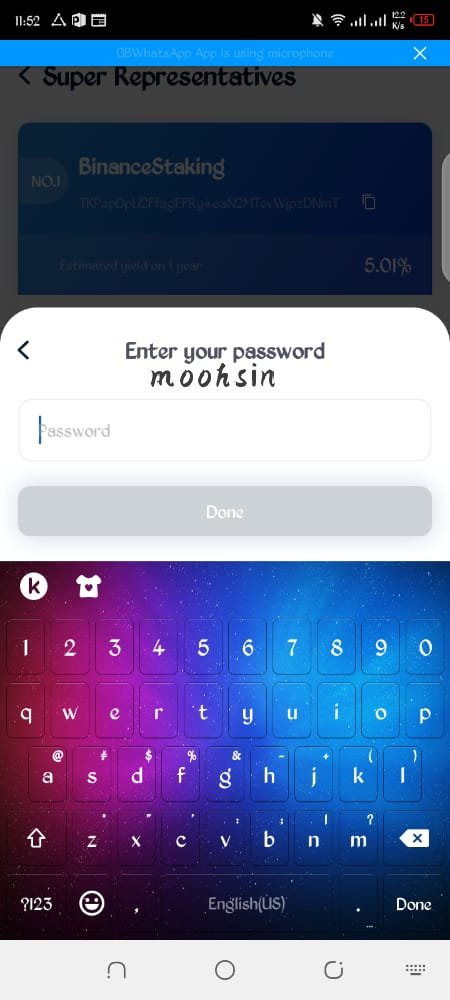
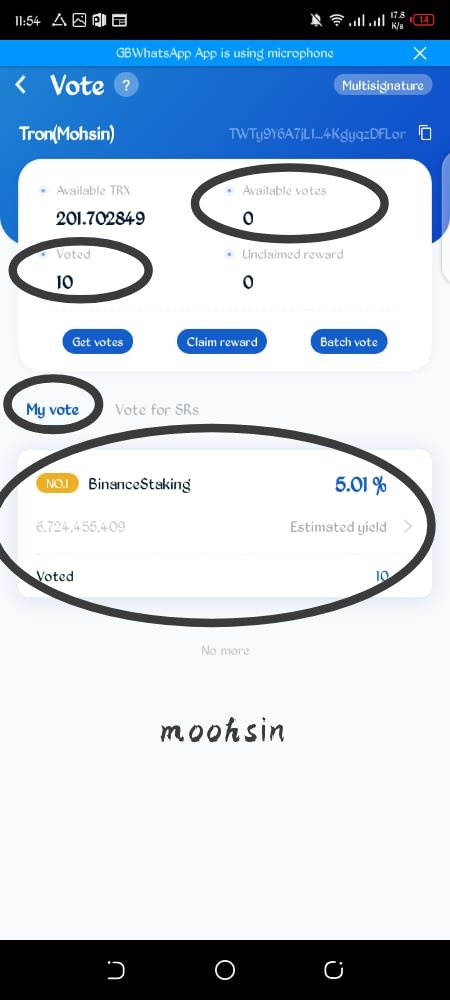

Conclusion:
Delegated Proof of Stake has been Proof of Stake's greatest worry, and there is no doubt that DPOS has been a significant benefit to the blockchain and cryptocurrency in general, allowing for rapid and flawless operations as well as large data storage on its blockchain. It has allowed users to keep their coins while still having a say in blockchain governance. It's no surprise that projects are quickly embracing DPOS, and that there will be more in the future.
Super Representatives and their partners play a critical role in the Tron ecosystem, which cannot be overstated. We exhibit faith in their ability to make decisions that are in the best interests of all Tron blockchain users by continuing to vote for them with staked TRX tokens.

Cc: @yohan2on
Hi @moohsin
Thanks for participating in the Steemit Crypto Academy
Feedback
Total| 7/10
This is good work. Thanks for taking the time to learn about the Governance of the Tron ecosystem.